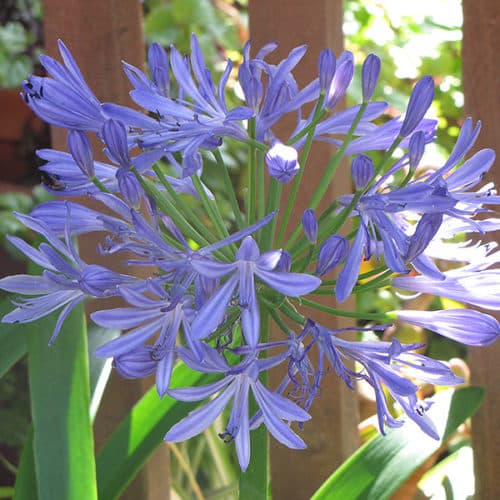Agapanthus Treatment Tips for Lush and Vibrant Flowers
Agapanthus Treatment Tips for Lush and Vibrant Flowers
Blog Article
Grasping the Art of Agapanthus Care: Necessary Actions for Healthy Development and Lively Blossoms
In the realm of gardening, the farming of agapanthus stands as a fulfilling undertaking for those who look for to support these classy blooming plants. With their striking flowers and stylish vegetation, agapanthus has recorded the attention of gardeners worldwide. Nevertheless, attaining optimum growth and vivid blooms requires a nuanced approach that includes different important actions. From choosing the best range to grasping pruning methods, the journey in the direction of cultivating growing agapanthus plants is diverse and holds the crucial to unlocking the complete potential of these agricultural gems.

Picking the Right Agapanthus Variety

When choosing the right Agapanthus selection for your garden, consider aspects such as climate viability, flower shade, and development habit. In addition, think about the environment in your region to make certain the Agapanthus range you select can prosper in your particular problems. Understanding the development practice of different Agapanthus varieties is critical for appropriate positioning within your garden.
Perfect Planting Conditions
Considering the ideal ecological demands is crucial for successful Agapanthus growing. Agapanthus thrives in well-draining soil with a slightly acidic to neutral pH degree. When planting, select a location that gets complete sunlight to partial shade. In hotter climates, offering some afternoon color can prevent scorching of the leaves. Agapanthus plants are sensitive to chilly temperatures and ought to be shielded from frost throughout winter season.
To guarantee healthy growth and vibrant blooms, plant Agapanthus light bulbs at a deepness of concerning 2-4 inches and room them 8-12 inches apart. Mulching around the base of the plants aids maintain wetness and reduces weed development.
Watering and Fertilizing Tips
Preserving correct wetness levels and providing important nutrients are vital aspects in the treatment regimen for Agapanthus plants. It is essential to strike a balance when it comes to watering Agapanthus. These plants prefer regularly moist soil but are susceptible to root rot if overwatered. Throughout the expanding period, water deeply when a week, guaranteeing the soil is well-draining to stop waterlogging. In hotter environments or during periods of dry spell, more frequent watering might be needed to keep the dirt uniformly moist. Nonetheless, minimize watering in the winter season to stop water logged conditions.
Feeding Agapanthus is vital for advertising healthy and balanced development and respected flowers. Use a balanced fertilizer, such as a 10-10-10 formula, in the very early springtime as new development arises. By following these watering and fertilizing ideas, you can guarantee your Agapanthus plants thrive and create lively, durable blooms.
Pruning Methods for Agapanthus
Trimming Agapanthus plants at the appropriate times and with proper methods is critical for maintaining their health and promoting ideal development and blooming. The ideal time to prune Agapanthus is in late winter season or very early springtime prior to brand-new development arises. Beginning by removing any dead or yellowing leaves near the base of the plant. Cut them as close to the ground as possible without damaging the emerging shoots.
Deadheading invested blossoms can also redirect the plant's power right into creating more blossoms instead than setting seeds. If you want to accumulate seeds for breeding, leave some flowers to completely dry and mature on the plant.
Remember to make use of tidy, sharp tools to make precise cuts and lower the danger of introducing diseases. Agapanthus. Normal pruning will aid keep your Agapanthus looking healthy and neat while making certain an abundant go to website display of gorgeous blossoms
Taking Care Of Common Bugs and Illness
After making sure correct pruning strategies for Agapanthus, it is necessary to address typical pests and illness that can influence the health and vitality of these plants. One usual pest that impacts Agapanthus is the Agapanthus gall midget.
In addition, Agapanthus plants can endure from origin rot if they are grown in poorly draining soil. By being watchful and taking prompt action versus diseases and pests, you can assist your Agapanthus plants grow and produce lively flowers. Agapanthus.

Conclusion
Finally, understanding the art of agapanthus review care entails picking the ideal range, offering perfect planting problems, correct watering and fertilizing, suitable pruning strategies, and resolving typical insects and conditions. By adhering to these vital actions, you can make sure healthy development and lively flowers for your agapanthus plants. Remember to routinely check and preserve your plants to promote their total wellness and longevity.
To make sure healthy development and lively blooms, plant Agapanthus light bulbs at a depth of concerning 2-4 inches and space them 8-12 inches apart. By following these watering and feeding tips, you can guarantee your Agapanthus plants thrive and generate dynamic, long-lasting flowers.
One common bug that affects Agapanthus is the Agapanthus gall midget. Additionally, Agapanthus plants can endure from root rot if they are grown in poorly draining pipes soil. By complying with these essential more tips here steps, you can make certain healthy development and vibrant flowers for your agapanthus plants.
Report this page